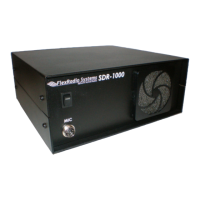S E T U P F O R M C H A P T E R 8
Phase: Sets the phase offset between the I and Q channels. Ideally, the phase angle difference
between I and Q (right and left channels) of a tone in our passband will be 90 degrees.
Gain: Sets the amplitude offset between the I and Q channels. Ideally, the amplitude of both I and
Q (left and right) channels of a received tone will be equal.
Transmit Rejection
Figure 88: Transmit Rejection
Similarly to above, these controls enable the user to adjust the image rejection for the transmitter. Unlike
Receive Rejection however, this is not an automatic procedure. The calibration requires external
instruments. A spectrum analyzer is ideal but a second receiver should enable you to get satisfactory
rejection levels.
To minimize the transmit image, proceed as follows:
1. Set the radio to either USB or LSB. Connect the radio to a dummy load and select Enable TX
Image Tone.
2. Click MOX (front console) and a full strength tone will be transmitted at the frequency shown in
VFO A. Adjust the output power with the Drive control (front console).
3. If the radio is set to USB, look at the image signal BELOW the carrier in either the spectrum
analyzer or the second receiver. If set to LSB, look at the image signal ABOVE the carrier.
4. Using Phase and Gain controls, null the relevant image signal.
Note: The image rejection will only work in an asymmetric voice mode (SSB).
In a symmetric voice mode, like AM, SAM, and FMN any small amount
of image problem will likely be covered up.
[The rest of this page has been left blank intentionally]
91 FlexRadio Systems

